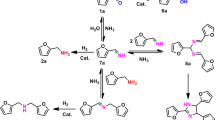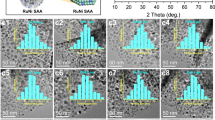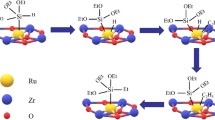Abstract
The transition from homogeneous to heterogeneous synthetic chemistry enabled by nanocatalysts necessitates investigations of the reaction mechanism and structure-activity relationships for inorganic nanoparticles and organic substrates. Herein, we report that hydrothermally synthesized ruthenium nanoparticles performed differently in the Se–Se bond activation and selenylation of heterocycles, exhibiting a volcano-shaped relationship between catalytic activity and composition. A synergistic effect was observed for Ru-RuO x nanocatalysts, with numerous characterizations and density functional theory (DFT) calculations suggesting that a PhSeSePh molecule can initially be adsorbed on the metallic Ru sites and cleaved into two PhSe* species, which subsequently migrate to RuO x sites and react with the nucleophile to achieve the selenylation of heterocycles.

Similar content being viewed by others


References
Schlögl, R.; Hamid, S. B. A. Nanocatalysis: Mature science revisited or something really new? Angew. Chem., Int. Ed. 2004, 43, 1628–1637.
Astruc, D.; Lu, F.; Aranzaes, J. R. Nanoparticles as recyclable catalysts: The frontier between homogeneous and heterogeneous catalysis. Angew. Chem., Int. Ed. 2005, 44, 7852–7872.
Wang, D. S.; Xie, T.; Li, Y. D. Nanocrystals: Solutionbased synthesis and applications as nanocatalysts. Nano Res. 2009, 2, 30–46.
Lee, I.; Delbecq, F.; Morales, R.; Albiter, M. A.; Zaera, F. Tuning selectivity in catalysis by controlling particle shape. Nat. Mater. 2009, 8, 132–138.
Polshettiwar, V.; Varma, R. S. Green chemistry by nanocatalysis. Green Chem. 2010, 12, 743–754.
Zahmakıran, M.; Özkar, S. Metal nanoparticles in liquid phase catalysis; from recent advances to future goals. Nanoscale 2011, 3, 3462–3481.
Chng, L. L.; Erathodiyil, N.; Ying, J. Y. Nanostructured catalysts for organic transformations. Acc. Chem. Res. 2013, 46, 1825–1837.
Li, Z.-X.; Xue, W.; Guan, B.-T.; Shi, F.-B.; Shi, Z.-J.; Jiang, H.; Yan, C.-H. A conceptual translation of homogeneous catalysis into heterogeneous catalysis: Homogeneous-like heterogeneous gold nanoparticle catalyst induced by ceria supporter. Nanoscale 2013, 5, 1213–1220.
Jiang, B. J.; Song, S. Z.; Wang, J. Q.; Xie, Y.; Chu, W. Y.; Li, H. F.; Xu, H.; Tian, C. G.; Fu, H. G. Nitrogen-doped graphene supported Pd@PdO core–shell clusters for C–C coupling reactions. Nano Res. 2014, 7, 1280–1290.
Wang, S.-B.; Zhu, W.; Ke, J.; Lin, M.; Zhang, Y.-W. Pd-Rh nanocrystals with tunable morphologies and compositions as efficient catalysts toward Suzuki cross-coupling reactions. ACS Catal. 2014, 4, 2298–2306.
Wang, F.; Li, C.; Chen, H.; Jiang, R.; Sun, L.-D.; Li, Q.; Wang, J.; Yu, J. C.; Yan, C.-H. Plasmonic harvesting of light energy for Suzuki coupling reactions. J. Am. Chem. Soc. 2013, 135, 5588–5601.
Wu, Y. E.; Li, Y. D. New understanding of phase segregation of bimetallic nanoalloys. Sci. China Mater. 2015, 58, 3–4.
Dai, L.-X.; Zhu, W.; Lin, M.; Zhang, Z.-P.; Gun, J.; Wang, Y.-H.; Zhang, Y.-W. Self-supported composites of thin Pt–Sn crosslinked nanowires for the highly chemoselective hydrogenation of cinnamaldehyde under ambient conditions. Inorg. Chem. Front. 2015, 2, 949–956.
Xiao, B.; Niu, Z. Q.; Wang, Y.-G.; Jia, W.; Shang, J.; Zhang, L.; Wang, D. S.; Fu, Y.; Zeng, J.; He, W. et al. Copper nanocrystal plane effect on stereoselectivity of catalytic deoxygenation of aromatic epoxides. J. Am. Chem. Soc. 2015, 137, 3791–3794.
Guo, H. F.; Yan, X. L.; Zhi, Y.; Li, Z. W.; Wu, C.; Zhao, C. L.; Wang, J.; Yu, Z. X.; Ding, Y.; He, W. et al. Nanostructuring gold wires as highly durable nanocatalysts for selective reduction of nitro compounds and azides with organosilanes. Nano Res. 2015, 8, 1365–1372.
Chen, Y. G.; Yu, Z. J.; Chen, Z.; Shen, R. A.; Wang, Y.; Gao, X.; Peng, Q.; Li, Y. D. Controlled one-pot synthesis of RuCu nanocages and Cu@Ru nanocrystals for the regioselective hydrogenation of quinoline. Nano Res. 2016, 9, 2632–2640.
Gong, M.; Wang, D.-Y.; Chen, C.-C.; Hwang, B.-J.; Dai, H. J. A mini review on nickel-based electrocatalysts for alkaline hydrogen evolution reaction. Nano Res. 2016, 9, 28–46.
Zhang, Z.-P.; Wang, X.-Y.; Yuan, K.; Zhu, W.; Zhang, T.; Wang, Y.-H.; Ke, J.; Zheng, X.-Y.; Yan, C.-H.; Zhang, Y.-W. Free-standing iridium and rhodium-based hierarchically-coiled ultrathin nanosheets for highly selective reduction of nitrobenzene to azoxybenzene under ambient conditions. Nanoscale 2016, 8, 15744–15752.
Casini, A.; Winum, J. Y.; Montero, J. L.; Scozzafava, A.; Supuran, C. T. Carbonic anhydrase inhibitors: Inhibition of cytosolic isozymes I and II with sulfamide derivatives. Bioorg. Med. Chem. Lett. 2003, 13, 837–840.
Mellah, M.; Voituriez, A.; Schulz, E. Chiral sulfur ligands for asymmetric catalysis. Chem. Rev. 2007, 107, 5133–5209.
Murphy, A. R.; Fré chet, J. M. J. Organic semiconducting oligomers for use in thin film transistors. Chem. Rev. 2007, 107, 1066–1096.
Sato, T.; Nishio, M.; Ishii, Y.; Yamazaki, H.; Hidai, M. Synthesis and reactivities of the indenyl-ruthenium cluster [(?5-C9H7)Ru(µ-SEt)]3: Indenyl effect in the trinuclear ruthenium cluster. J. Organomet. Chem. 1998, 569, 99–108.
Belletti, D.; Graiff, C.; Lostao, V.; Pattacini, R.; Predieri, G.; Tiripicchio, A. Sulfido–carbonyl ruthenium clusters derived from tertiary phosphine sulfides. Inorg. Chim. Acta 2003, 347, 137–144.
Becker, E.; Mereiter, K.; Schmid, R.; Kirchner, K. Facile S-S bond activation of alkyl and aryl disulfides by [RuCp(CH3CN)3]+: Formation of dinuclear Ru(III)-Ru(III) complexes with bridging thiolate ligands. Organometallics 2004, 23, 2876–2883.
Maiti, B. K.; Gö rls, H.; Klobes, O.; Imhof, W. A straightforward and generalizable synthetic methodology for the synthesis of ruthenium(II) complexes with thioether ligands from either Ru(III) or Ru(0) precursors. Dalton Trans. 2010, 39, 5713–5720.
Begum, N.; Hyder, M. I.; Hassan, M. R.; Kabir, S. E.; Bennett, D. W.; Haworth, D. T.; Siddiquee, T. A.; Rokhsana, D.; Sharmin, A.; Rosenberg, E. Facile E-E and E-C bond activation of PhEEPh (E = Te, Se, S) by ruthenium carbonyl clusters: Formation of di- and triruthenium complexes bearing bridging dppm and phenylchalcogenide and capping chalcogenido ligands. Organometallics 2008, 27, 1550–1560.
Nagarajaprakash, R.; Ramakrishna, B.; Mahesh, K.; Mobin, S. M.; Manimaran, B. One-pot synthesis of ruthenium metallacycles via oxidative addition of diaryldichalcogen and halogen across a Ru–Ru bond. Organometallics 2013, 32, 7292–7296.
Horiuchi, S.; Murasem, T.; Fujita, M. Noncovalent trapping and stabilization of dinuclear ruthenium complexes within a coordination cage. J. Am. Chem. Soc. 2011, 133, 12445–12447.
Yao, S. A.; Martin-Diaconescu, V.; Infante, I.; Lancaster, K. M.; Götz, A. W.; DeBeer, S.; Berry, J. F. Electronic structure of Ni2E2 complexes (E = S, Se, Te) and a global analysis of M2E2 compounds: A case for quantized E2n–oxidation levels with n = 2, 3, or 4. J. Am. Chem. Soc. 2015, 137, 4993–5011.
Aufieco, M.; Sperger, T.; Tsang, A. S.-K.; Schoenebeck, F. Highly efficient C-SeCF3 coupling of aryl iodides enabled by an air-stable dinuclear PdI catalyst. Angew. Chem., Int. Ed. 2015, 54, 10322–10326.
Yin, A. X.; Liu, W.-C.; Ke, J.; Zhu, W.; Gu, J.; Zhang, Y.-W.; Yan, C.-H. Ru nanocrystals with shape-dependent surface-enhanced Raman spectra and catalytic properties: Controlled synthesis and DFT calculations. J. Am. Chem. Soc. 2012, 134, 20479–20489.
Sang, P.; Chen, Z. K.; Zou, J. W.; Zhang, Y. H. K2CO3 promoted direct sulfenylation of indoles: A facile approach towards 3-sulfenylindoles. Green Chem. 2013, 15, 2096–2100.
Azeredo, J. B.; Godoi, M.; Martins, G. M.; Silveira, C. C.; Braga, A. L. A solvent- and metal-free synthesis of 3-chacogenyl-indoles employing DMSO/I2 as an eco-friendly catalytic oxidation system. J. Org. Chem. 2014, 79, 4125–4130.
Vásquez-Céspedes, S.; Ferry, A.; Candish, L.; Glorius, F. Heterogeneously catalyzed direct C-H thiolation of heteroarenes. Angew. Chem., Int. Ed. 2015, 54, 5772–5776.
Ferreira, N. L.; Azeredo, J. B.; Fiorentin, B. L.; Braga, A. L. Synthesis of 3-selenylindoles under ecofriendly conditions. Eur. J. Org. Chem. 2015, 23, 5070–5074.
Lewera, A.; Zhou, W. P.; Vericat, C.; Chung, J. H.; Haasch, R.; Wieckowski, A.; Bagus, P. S. XPS and reactivity study of bimetallic nanoparticles containing Ru and Pt supported on a gold disk. Electrochim. Acta 2006, 51, 3950–3956.
Mazzieri, V.; Coloma-Pascual, F.; Arcoya, A.; L’Argentière, P. C.; Figoli, N. S. XPS, FTIR and TPR characterization of Ru/Al2O3 catalysts. Appl. Surf. Sci. 2003, 210, 222–230.
Mitsudome, T.; Takahashi, Y.; Mizugaki, T.; Jitsukawa, K.; Kaneda, K. Hydrogenation of sulfoxides to sulfides under mild conditions using ruthenium nanoparticle catalysts. Angew. Chem., Int. Ed. 2014, 53, 8348–8351.
Vogel, W.; Kaghazchi, P.; Jacob, T.; Alonso-Vante, N. Genesis of RuxSey nanoparticles by pyrolysis of Ru4Se2(CO)11: A combined X-ray in situ and DFT study. J. Phys. Chem. C 2007, 111, 3908–3913.
Inukai, J.; Cao, D. X.; Wieckowski, A.; Chang, K.-C.; Menzel, A.; Komanicky, V.; You, H. In situ synchrotron X-ray spectroscopy of ruthenium nanoparticles modified with selenium for an oxygen reduction reaction. J. Phys. Chem. C 2007, 111, 16889–16894.
Haas, S.; Zehl, G.; Dorbandt, I.; Manke, I.; Bogdanoff, P.; Fiechter, S.; Hoell, A. Direct accessing the nanostructure of carbon supported Ru-Se based catalysts by ASAXS. J. Phys. Chem. C 2010, 114, 22375–22384.
Ramaswamy, N.; Allen, R. J.; Mukerjee, S. Electrochemical kinetics and X-ray absorption spectroscopic investigations of oxygen reduction on chalcogen-modified ruthenium catalysts in alkaline media. J. Phys. Chem. C 2011, 115, 12650–12664.
Cánaves, M. M.; Cabra, M. I.; Bauzá, A.; Cañellas, P.; Sánchez, K.; Orvay, F.; García-Raso, A.; Fiol, J. J.; Terrón, A.; Barceló-Oliver, M. et al. Crystal structures and DFT calculations of new chlorido-dimethylsulfoxide-M(III) (M = Ir, Ru, Rh) complexes with the N-pyrazolyl pyrimidine donor ligand: Kinetic vs. thermodynamic isomers. Dalton Trans. 2014, 43, 6353–6364.
Gu, J.; Guo, Y.; Jiang, Y.-Y.; Zhu, W.; Xu, Y.-S.; Zhao, Z.-Q.; Liu, J.-X.; Li, W.-X.; Jin, C.-H.; Yan, C.-H. et al. Robust phase control through hetero-seeded epitaxial growth for face-centered cubic Pt@Ru nanotetrahedrons with superior hydrogen electro-oxidation activity. J. Phys. Chem. C 2015, 119, 17697–17706.
Liang, J.; Jiao, Y.; Jaroniec, M.; Qiao, S. Z. Sulfur and nitrogen dual-doped mesoporous graphene electrocatalyst for oxygen reduction with synergistically enhanced performance. Angew. Chem., Int. Ed. 2012, 51, 11496–11500.
Li, L. L.; Chen, X. B.; Wu, Y. E.; Wang, D. S.; Peng, Q.; Zhou, G.; Li, Y. D. Pd-Cu2O and Ag-Cu2O hybrid concave nanomaterials for an effective synergistic catalyst. Angew. Chem., Int. Ed. 2013, 52, 11049–11053.
Zhou, F.; Xin, S.; Liang, H.-W.; Song, L.-T.; Yu, S.-H. Carbon nanofibers decorated with molybdenum disulfide nanosheets: Synergistic lithium storage and enhanced electrochemical performance. Angew. Chem., Int. Ed. 2014, 53, 11552–11556.
Qadir, K.; Joo, S. H.; Mun, B. S.; Butcher, D. R.; Renzas, J. R.; Aksoy, F.; Liu, Z.; Somorjai, G. A.; Park, J. Y. Intrinsic relation between catalytic activity of CO oxidation on Ru nanoparticles and Ru oxides uncovered with ambient pressure XPS. Nano Lett. 2012, 12, 5761–5768.
Lettenmeier, P.; Wang, L.; Golla-Schindler, U.; Gazdzicki, P.; Cañas, N. A.; Handl, M.; Hiesgen, R.; Hosseiny, S. S.; Gago, A. S.; Friedrich, K. A. Nanosized IrOx–Ir catalyst with relevant activity for anodes of proton exchange membrane electrolysis produced by a cost-effective procedure. Angew. Chem., Int. Ed. 2016, 55, 742–746.
Gao, S.; Lin, Y.; Jiao, X. C.; Sun, Y. F.; Luo, Q. Q.; Zhang, W. H.; Li, D. Q.; Yang, J. L.; Xie, Y. Partially oxidized atomic cobalt layers for carbon dioxide electroreduction to liquid fuel. Nature 2016, 529, 68–71.
Luska, K. L.; Bordet, A.; Tricard, S.; Sinev, I.; Grü nert, W.; Chaudret, B.; Leitner, W. Enhancing the catalytic properties of ruthenium nanoparticle-SILP catalysts by dilution with Iron. ACS Catal. 2016, 6, 3719–3726.
Xiao, C. X.; Goh, T.-W.; Qi, Z. Y.; Goes, S.; Brashler, K.; Perez, C.; Huang, W. Y. Conversion of Levulinic acid to γ-valerolactone over few-layer graphene-supported ruthenium catalysts. ACS Catal. 2016, 6, 593–599.
Acknowledgements
We thank the National Natural Science Foundation of China (Nos. 21461162001, 21025101, 21371011, 21321001, 21229101, and 21331001), the National Basic Research Program of China (No. 2012CBA01204) for financial support, and the 7th China Postdoctoral Science Foundation Funded Project (No. 2014T70009). M. L. was also supported in part by the Postdoctoral Fellowship of Peking-Tsinghua Center for Life Sciences.
Author information
Authors and Affiliations
Corresponding authors
Electronic supplementary material
Rights and permissions
About this article
Cite this article
Lin, M., Kang, L., Gu, J. et al. Heterogeneous synergistic catalysis by Ru-RuO x nanoparticles for Se–Se bond activation. Nano Res. 10, 922–932 (2017). https://doi.org/10.1007/s12274-016-1350-0
Received:
Revised:
Accepted:
Published:
Issue Date:
DOI: https://doi.org/10.1007/s12274-016-1350-0


